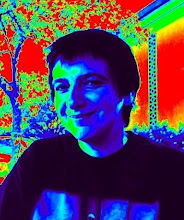
It was 1980 when I made the transition from first to second school cycle, from elementary to junior high school, or middle school as it's called in those parts of the world. In the same year America elected Ronald Reagan and Europe braced for the inevitable Cold War escalation that would shortly follow. The feeling of impending catastrophe was palpable and real: most people in Europe at that time expected a nuclear war between the two superpowers to be a very concrete near future scenario. The Pentagon hawks seemed unstoppable. Were we supposed to look at those icy figures in the Kremlin, at the likes of Yuri Andropov and Konstantin Chernenko, for the hero that would rescue Europe from this madness? The future looked bleak, the clouds of war seemed to be gathering with increasing strength. Every year the stockpiles of warheads in the nuclear arsenals kept growing, ready to annihilate life on Earth many times over. The strategy of deterrence that had kept the superpowers in check for so long was being undermined by the first talks of "Strategic Defense Initiative", the infamous "Star Wars" scheme. The perspective of Europe disappearing in a ball of thermonuclear fire felt suddenly very real.

It was the years of remarkable cinema productions that raised awareness in the population about the real meaning of nuclear war, beyond the silly "duck and cover" propaganda of the previous decades. When the beautiful British animation "When the wind blows" came out in movie theaters I went to several shows. I saw all the rest as well in a short span of time afterwards: from the magnificent 1960s classics like "Dr. Strangelove" to the recent productions, the somewhat cheesy American "The Day After" and the chilling British reply on the same theme, "Threads". I quickly developed a fascination for nuclear energy and the workings of peaceful and military applications of the same.

I felt for the first time quite certain of what I wanted to do as a grownup: I wanted to become a nuclear physicists. If the human mind was able to control such immense and ominous source of energy by splitting the atom, if it was capable of constructing hydrogen bombs that could recreate the sun on earth, then I wanted to be that mind. If our fate is to die in thermonuclear fire, then better be the masters of our destiny than its slaves. I was especially attracted by the long and difficult training involved in becoming a nuclear scientist, the advanced mathematics, the physics of the quantum world. I wanted to face that challenge, I wanted to start learning what school deferred far too long. I went to the only place where I knew I could get good math and physics books at a cost we could afford: the local section of the Communist Party and its Association for Cultural Exchanges with the Soviet Union. That's how I had my first encounter with the Mir international editions: scientific books published in the Soviet Union in a varieties of languages and sold in various countries at subsidized prices. I got away with about ten math and physics books, most of them too advanced for my age, but slowly conquered over the following years, and with the Collected Works of Lenin added to the bunch for less than the cost of a meal at the school cafeteria.

My mother had a subscription to Scientific American since the year before I was born. During my three years in junior high, I voraciously read eleven years of the back issues plus every new one that arrived each month. In those days, at least in the local edition, each issue had an article about issues related to nuclear energy, nuclear weapons, perspectives for the future developments of the Cold War. The other main source of excitement in the Scientific American issues of 1979-1980 were the two Voyager missions and their encounters with the giant planets and their moons. The descriptions of the new worlds: the volcanos of Io, the Ocean of Europa, the rings of Saturn. There were other marvels: superconductors, cellular automata, the pioneering days of neuroscience, the very early steps in the miniaturization of electronics.

I suffered from a serious physical injury while playing basketball in the school team during my second year in junior high. The ligament of my left knee essentially disintegrated. It is still presently in that pitiful state, which severely limits the range of sports I can play. I was confined to a long convalescence, which I spent reading all the remaining Scientific American issues and every other book I could lay my hands on that had to do with physics or mathematics. I gradually expanded my aspirations of a future life as a physicists from the domain of nuclear energy to the wonders of planetary science, radio-astronomy, electronics, and whatever could be talked about in terms of equations and their solutions. I cultivated my ideal of the scientific hero, something along the lines of a Sergei Lvovich Sobolev, director of the Soviet Institute for the Atomic Energy with its own A-bomb project on the side of the discoveries of basic science and higher mathematics. I was a Cold War monster, and immensely proud of it.

